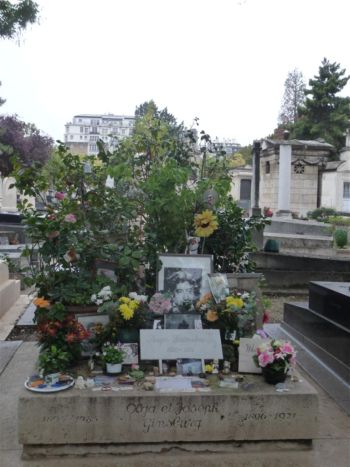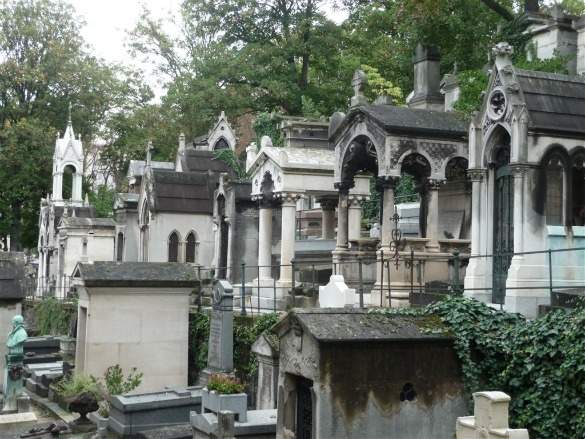Paris may be the City of Lights but don’t let the epithet fool you. The illustrious capital of chic is also a world-class city of the dead, and there’s no better time for conjuring spirits in Paris’s creepy catacombs and world-famous cemeteries than on Halloween and La Toussaint, the solemn French national holiday on November 1st when Paris’s cemeteries come alive to honor the dead.
The Catacombs of Paris are a bone chiller on All Hallow’s Eve, or any eve for that matter. Morbidly fascinating, what lies beneath Paris’s hip, bustling fourteenth arrondissement is definitely not for the faint of heart. In the late seventeen hundreds the rancid, overpopulated Cemetery of the Innocents smack-dab in the center of Paris was condemned a health hazard. Centuries’ worth of remains were exhumed from its oozing earth and as many as six million Parisians were transferred to stone quarries deep beneath the city’s southern edge at Port d’Enfer — befittingly, the Gate of Hell.

After visitors brave a chilly greeting above the entrance — “Arret! C’est ici l’empire de la Mort!” (“Stop! Here is the city of the Dead!”) – they pass into a damp, musty, seemingly endless network of dimly-lit caverns and tunnels bulging with punctiliously arranged stacks of skulls and bones. Only about a mile of the one-hundred-and-eighty mile subterranean ossuary can be visited, but that much is vivid and gripping enough. Bones are piled five feet high in some places, some even with creative flair. Crosses formed by hollow-eyed skulls embedded in femur walls are a frequent sight, and a towering barrel of cracked skulls looms in the darkness just before the very welcoming exit.
In the much more salubrious open air, Paris’s cemeteries are lush, park-like labyrinths overflowing with lavish graves that boast sculptures, tombs and monuments ranging from the kitschy to the otherworldly. They make a bewitching visit in late autumn when falling gold, chestnut, and rust-colored leaves offer a peek at branchy skeletons and the crisp air sends vivifying chills up grave-hoppers’ spines.

Père Lachaise, Montparnasse and Montmartre Cemeteries are Paris’s most beautiful and beloved bone yards. They are renowned “celebrity” cemeteries where musicians, politicians, writers, artists, and personalities revered the globe over turn to dust. Ambling along their tomb-lined lanes is especially moving on La Toussaint, the day after Halloween when the French flock to cemeteries in reverence of All Saint’s Day and All Soul’s Day. A spellbinding sight, cemeteries are alight with candles and showered in chrysanthemums left by loved ones in memory of the dead. Since florists and cemeteries are the only places open in Paris, among the bones is the optimal way to respect the holiday.
Paris’s oldest and largest cemetery, Père Lachaise is also Paris’s most famous necropolis thanks to its unrivaled celebrity corpse factor. In fact, star power has been Père Lachaise’s cardinal charm from the get-go. After Père Lachaise was established under Napoleon in 1804, the remains of La Fontaine and Moliere were transferred here in order to up the value and prestige of plots in the sprawling hillside cemetery, back then in a poor, dodgy and out of the way district on the eastern fringe of Paris. The brilliant PR stunt worked. For the famous and Paris’s ordinary citizens literally dying to be buried next to them, Père Lachaise’s wormy real estate became all the rage.
A million people a year now comb the winding, august paths and gardens that are home to a whopping three hundred thousand graves. Jim Morrison’s debased graffiti-splotched plot and Oscar Wilde’s castrated, lipstick-smeared, art deco tomb top every good taphophile’s list. Chopin, Balzac, Gertrude Stein, Modigliani and Richard Wright are a motley handful of other impressive inhabitants.
With its glowing-eyed feral cats and swooping black crows, Montmartre Cemetery is the eerie epitome of Halloween spirit. Far creepier than the garden-like Père Lachaise any day, Montmartre’s densely planted terrain of gothic mausoleums and ominous overgrown plots, some of which lie under the intrusive, suspended carcass of train tracks, is blinged-out in all manner of zany and ostentatious grave art.

Whoever said you can’t take it with you has obviously never set foot in Montmartre (or any Paris cemetery for that matter). Its VIP plots — Stendhal, Dalida, Alexander Dumas — may be the big draw, but it’s often the lesser-knowns whose tombstones defy expectation. While a refreshingly underwhelming slab of black marble marks the grave of acclaimed French director Francois Truffaut, a hulking bronze replica of Michelangelo’s Moses, glorious flowing beard-in-hand and all, presides over the plot of French philanthropist (and, this author suspects, megalomaniac) Daniel Osiris. Less gaudy but just as wacky is a demented little statue of Vaslav Nijinsky as the puppet Petrushka that keeps watch over the Russian dancer’s grave.
Montparnasse Cemetery, opened on the southern edge of Paris’s old city limits in 1824, might be a stone’s throw from the catacombs but it is a world away from their gloom and doom. The cemetery boasts twelve hundred lime, cedar and maple trees, making it one of the largest, most serene and, despite all those corpses, inviting green spaces in Paris.
Like Père Lachaise and Montmartre, Montparnasse is another who’s who of the great forever after. Jean Paul Sartre practically greets visitors at the cemetery’s gates, butler for a heady crowd of eternally a-slumber intellectuals like Baudelaire, Susan Sontag, Samuel Beckett, and Guy de Maupassant. Serge Gainsbourg’s grave is also wildly popular. It is perpetually adorned in fresh flowers, metro tickets and a heaping mound of plastic lighters in memoriam of the beloved chain-smoking French singer’s treasured Gauloises.
Native LA woman Jennifer Theriault is a Paris-based writer going on five years as an uninnocent abroad. You can catch her evolving two cents on her blog Pink Vanilla and in History 102, her brand spankin’ new column for The American.